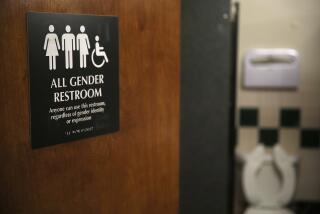Op-Ed: Do men really talk too much?

- Share via
Fifty years after the birth of feminism, when its promise of gender liberation seemed closer and more distant than ever before, the word mansplaining arose to describe male domination of speech. Derived from an essay by the journalist Rebecca Solnit, mansplaining started as a joke, then appeared on the New York Times “word of the year” list and was added to the Oxford English Dictionary.
The word succeeded because it describes a common social scenario so aptly. Solnit’s inspiration was a man at a party who, on learning that she had written a book about the film pioneer Eadweard Muybridge, lectured her on a recent book about Muybridge, which happened to be Solnit’s book. It was yet another case of a man, confronted with a knowledgeable woman, displaying his knowledge to the maximum. We have all witnessed similar scenes.
Solnit argued that these tiny but ubiquitous social interactions amount, in aggregate, to a politics of silence. In ways big and small, men have too much say, she wrote in “Men Explain Things to Me.”
But there is an empirical question that Solnit never addressed in that book: Do men in fact talk more than women? In her 2006 book, “The Female Brain,” the neuropsychiatrist Louann Brizendine claimed that the average woman uses nearly three times as many words as the average man. Other researchers disagreed vociferously. At the University of Arizona, a group of sociologists attached voice recorders to 396 participants and found no statistical difference in how much men and women spoke. “The widespread and highly publicized stereotype about female talkativeness is unfounded,” they wrote. The stereotype being that women, not men, have too much say.
If men and women are from different tribes or different planets, then we are doomed to a permanent stand-off.
In 2014, Harvard researchers using electronic monitoring found that men and women spoke more or less depending on the size of the group and the setting. While collaborating on a work project in groups of seven or fewer, women talked more and men talked less. During a lunch break, women spoke more when they were in large groups, and men talked more when they were in small groups.
A recent California State University study of email exchanges, measuring number of words per message and number of messages per exchange, found that women wrote more than men across a range of situations, in both work and personal messages. The researchers concluded that “electronic communications may level the playing field, or even give females an advantage, in certain communication situations.” The stereotype up for rejection in this case being that men won’t shut up.
Who talks more has been one of the traditional battlegrounds in the gender wars. At the beginning of the feminist revolution, male reserve rather than male speech was the symptom of failure. In 1971, the sociologists Jack Balswick and Charles Peek wrote in “The Inexpressive Male” that “as sex role distinctions have developed in America, the male sex role, as compared to the female sex role, carries with it prescriptions which encourage inexpressiveness.”
For the men courageous and sensitive enough to recognize the import of the feminist revolution, the first requirement was expression: expression as release from frozen Stoic ideals and expression as the beginning of a considerate masculinity. Men were encouraged to talk more, not less, particularly around women.
The irony probably won’t comfort Solnit, but the man blathering on at that party is, in certain respects, the result of this conscious program to overcome gender restrictions, to make men give more of themselves.
The irony runs deeper than awkward scenes at parties. The entire discussion of mansplaining operates on the assumption that people who talk more socially are demonstrating more power. They aren’t. Reserved speech has been the marker of masculine power for millennia. The strong silent type has an ancient pedigree. “Speak softly and carry a big stick” was Theodore Roosevelt’s definition of U.S. foreign policy and, like so many descriptions of U.S. foreign policy, also a stand-in for fantasies of masculinity.
Baldessare Castiglione in “The Book of the Courtier,” the guide to gentlemanly etiquette popular across Europe during the Renaissance, advised as early as 1528 that a gentleman keeps everything but his most certain opinions to himself: “Let him be circumspect in keeping them close, lest he make other men laugh at him.”
In the early 16th century, men and women both were laughing at men who talked too much about things they didn’t understand. And that is the correct response to the guy who told Solnit about her own book: to laugh in his face. Laugh at him because he’s weak.
I recognize that I am now mansplaining mansplaining. Behind that absurdity lies a despair that has haunted the feminist revolution from the beginning: the despair that men and women cannot understand each other. Despair over language is the deepest despair. If equality eludes us even in our words, how can we dream of justice in our bodies?
The classic books of intergender linguistics have always betrayed a shared hopelessness, even in their titles: “Men Are from Mars, Women Are from Venus.” “That’s Not What I Meant!”
“Male-female conversation is cross-cultural communication,” Deborah Tannen wrote, depressingly, in “You Just Don’t Understand.” Men and women need translators, like those at high-power summit meetings.
If men and women are from different tribes or different planets, then we are doomed to a permanent stand-off. The battle of the sexes will be never-ending and the gender wars ongoing and irresolvable. But our language fails us most of all when it comes to describing the state of gender itself. “The gender wars,” “the battle of the sexes” — these are disastrous metaphors. We have used the word war to describe the historical process of men and women beginning to live together as equals. We have used battle to describe the advent of deeper intimacies and more just laws.
The language of conflict is no longer useful. The future can belong only to men and women together. The most vital, the most profound changes in the lives of men and women have occurred in their lives together: in bed, in families, in workplaces. Gloria Steinem’s famous declaration is true: “Women’s Liberation is Men’s Liberation too.” The opposite is also true: Real liberation is men and women together. That means men will have to do some of the explaining.
Stephen Marche is a novelist and columnist. His latest book is “The Unmade Made: The Messy Truth About Men and Women in the 21st Century,” from which this essay was excerpted.
Follow the Opinion section on Twitter @latimesopinion or Facebook
More to Read
A cure for the common opinion
Get thought-provoking perspectives with our weekly newsletter.
You may occasionally receive promotional content from the Los Angeles Times.










